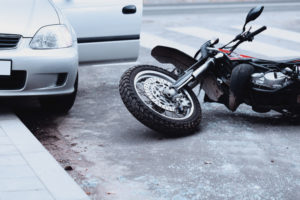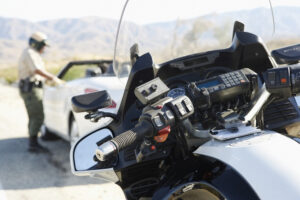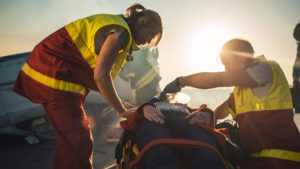Warm weather brings out flowers, Dogwood blossoms and motorcycles. After a cold winter when few motorcyclists ventured out on the roads of Virginia, and when drivers of 4-wheel vehicles got used to motorcycle free highways, the bikes are back in town. To bring motorcycles back onto the driving public’s radar, the National Highway Transportation and Safety Administration (NHTSA) has designated May as Motorcycle Safety Awareness Month.
NHTSA’S slogan for May is “Share the Road.” With that in mind, I talked with Sgt. S. Hackney of the Albemarle County, Va., Police Department, Sgt. R. Roberts of the Charlottesville, Va., Police Department and motorcycle rider instructor Anthony Riddle about the factors causing motorcycle crashes and fatalities in our area.
1. Following Too Closely. Motorcycle rider courses advise bikers to leave 2 – 3 seconds following distance between themselves and the vehicle in front of them. With a perception-reaction time of 1 – 1.5 seconds, even 2 -3 seconds can leave you little time to swerve or brake, particularly if your skills are rusty from lack of practice. If you are in a car following another car and fail to slow or stop, you may dent the rear of the car in front of you. If you are following a motorcycle, the consequences can be permanent.
2. “Drive like everybody is trying to hit you.” There are drivers on cell phones who are so involved in their conversations they don’t see your motorcycle. There are other drivers who see you but cut in front of you anyway to get that first position in the left lane at the traffic light, to make that urgent left turn across your path or just to pull out from a side road and dawdle along in your lane. Regardless of their motivation or the reason for their inattention, you need to have your mental radar on alert in traffic situations because every car is a potential hazard.
3. Speed. Although speed is often a factor in crashes in town, it is more common as a crash factor on rural roads. Speed reduces the time you have to perceive and react to hazards, whether it is an animal running into the road, gravel, cut grass or hay on the pavement, a blind curve that tightens on you, a bridge with wet planks or pavement that is full of holes. Speed also changes bike dynamics because of the weight shift onto the front wheel during hard braking, the need to get the bike vertical before you brake hard, and the increased degree of lean necessary to turn a bike in a curve at higher speeds. Bad things happen. And bad things happen faster at 70 mph or more on rural roads.
4. Visibility. A light colored helmet can increase your visibility in traffic. A green vest will also boost your visibility. In addition, moving left or right in your lane may get the attention of a driver about to pull into or across your lane. Asserting your right of way may be a reliable tactic for the driver of a Mack truck but not necessarily for a biker. Although spotting another motorcycle is easy for a biker, in traffic we are often invisible to those on four wheels.
5. Some Drivers You Just Need to Avoid. This past Saturday I checked my sideview mirror and saw a speeding SUV passing four cars behind me with the intent of making me number five. I moved up closer to the car in front of me and this overly aggressive driver, probably intoxicated and coming from the Foxfield Races, alternately rode my rear and lagged back for the next four miles of two lane road until a right turn lane into a subdivision enabled him to pass me and the car in front of me on our right before cutting back into our lane. I should have gotten off the road the first chance I had to get away from this driver.
6. DUI. Two fatal motorcycle crashes in our area last year involved bikers who had been drinking. Drinking impairs our perception and reactions, even before we reach the point of legally being under the influence. On a motorcycle, fractions of a second can make all the difference between a near miss and total wipeout. One fatal crash was caused by a drunk driver in a car crossing over into the oncoming lane and hitting a biker. Whether you are riding on four wheels or two, alcohol and driving is a dangerous combination.
7. Gear. It is surprising how many riders in sneakers, shorts and a t-shirt put on their helmets and believe they are good to go. One of the first things to go when sliding on pavement is skin. Which is why it is generally a good idea to put on a second skin when you get on a motorcycle. Good boots, long pants, a riding jacket and gloves. It’s not just about looking cool. We don’t have car bodies, padded seats and airbags to protect us. And putting on your gear is a way of emphasizing the seriousness of the fun of riding motorcycles. If you’re going to be in the game, wear the uniform. There’s a lot to choose from. And if you need to replace it because of a crash, it is a whole lot cheaper than skin grafting and plastic surgery.
8. Helmets. They are mandatory in Virginia. But don’t just stick it on your head. Fasten the strap. Police officers arrive at accident scenes and find bikers who didn’t fasten their helmet straps and lost their helmets in the crash.
9. Cornering. One study found that 68% of single vehicle motorcycle crashes involved cornering. Whether you weight your foot pegs in turns or use your thighs to lean the bike, slow down before the turn, look through the turn, lean the bike, roll on the throttle or keep it steady to maintain traction and stabilize the bike, and watch out for gravel, rocks, wet leaves, potholes and other hazards that can affect the control of your bike.
10. Lack of Training or Practice. Inexperience, lack of training, bad habits or just being out of practice can prevent us from recognizing a hazard or dealing with it effectively. Take a basic rider course or an experienced rider course. Watch a DVD on riding skills and practice what it shows. Go to an empty parking lot and practice slow turns, swerving and emergency breaking. Get a feel for your bike while practicing the types of maneuvers you may need on the streets.
11. Share the Road. It’s great when you have the road to yourself without a 4-wheeled vehicle in sight but most of the time this is not our reality. Last week I rode with a friend who, on the way to our meeting point, had been forced out of his lane by a woman in a van talking on a cell phone. Even when he tried to get her attention, she remained oblivious as she continued driving and talking on her cell phone. While anger may be our first reaction, it can undermine our better judgment and distract us from hazards we need to mind. When you get away from a driver like this, put your thoughts about them behind you to clear the decks mentally for the hazards ahead. If riding motorcycles was safe, everyone would do it and it wouldn’t be half the fun.
Click on Motorcycle Safety Awareness Month to see a 30-second public service announcement on motorcycle safety.

The Legal Examiner and our Affiliate Network strive to be the place you look to for news, context, and more, wherever your life intersects with the law.













Comments for this article are closed.